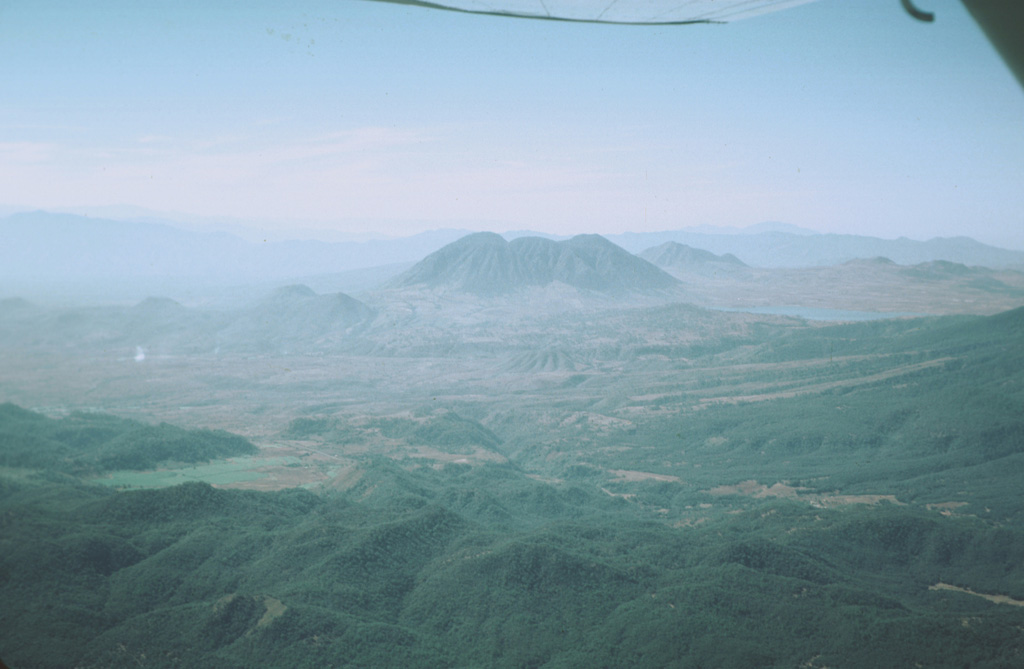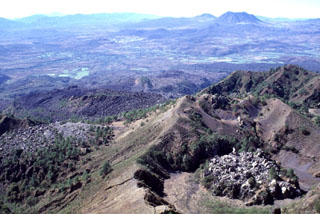

The Global Volcanism Program has no activity reports available for San Pedro.
The Global Volcanism Program has no Weekly Reports available for San Pedro.
The Global Volcanism Program has no Bulletin Reports available for San Pedro.
This compilation of synonyms and subsidiary features may not be comprehensive. Features are organized into four major categories: Cones, Craters, Domes, and Thermal Features. Synonyms of features appear indented below the primary name. In some cases additional feature type, elevation, or location details are provided.
Cones |
||||
| Feature Name | Feature Type | Elevation | Latitude | Longitude |
| Amado Nervo | Shield volcano | |||
| Grande, Cerro | Shield volcano | 1520 m | 21° 8' 0" N | 104° 45' 30" W |
| Tezontle, Volcán | Pyroclastic cone | |||
Domes |
||||
| Feature Name | Feature Type | Elevation | Latitude | Longitude |
| Agua Tibia, Cerro | Dome | |||
| Atarjea de Tescalame | Dome | |||
| Bartolinas, Cerro | Dome | |||
| Cuevas, Cerro las | Dome | |||
| Izote, Cerro | Dome | |||
| Limon, Cerro el | Dome | |||
| Lobos, Cerro | Dome | |||
| Ojotes, Los | Dome | |||
| Tetillas, Cerro las | Dome | |||
| Tetitlan, Cerro | Dome | |||
|
|
||||||||||||||||||
The Global Volcanism Program is not aware of any Holocene eruptions from San Pedro. If this volcano has had large eruptions (VEI >= 4) prior to 12,000 years ago, information might be found on the San Pedro page in the LaMEVE (Large Magnitude Explosive Volcanic Eruptions) database, a part of the Volcano Global Risk Identification and Analysis Project (VOGRIPA).
There is no Deformation History data available for San Pedro.
There is no Emissions History data available for San Pedro.
 The view of the 1870 vent and the San Pedro-Ceboruco graben is from the Ceboruco summit. The small lava dome to the lower right and the unvegetated lava flow to the lower left were emplaced during the 1870-75 eruption. The Cerro San Pedro lava dome on the horizon directly above the 1870 dome was constructed within the 7 x 10 km San Pedro caldera. The peak immediately left of Cerro San Pedro is Cerro Tetillas.
The view of the 1870 vent and the San Pedro-Ceboruco graben is from the Ceboruco summit. The small lava dome to the lower right and the unvegetated lava flow to the lower left were emplaced during the 1870-75 eruption. The Cerro San Pedro lava dome on the horizon directly above the 1870 dome was constructed within the 7 x 10 km San Pedro caldera. The peak immediately left of Cerro San Pedro is Cerro Tetillas. The indistinct elliptical 7 x 10 km wide San Pedro caldera is seen here in an aerial view from the NE, with Laguna San Pedro on the right. The rim of the caldera is exposed only on the east side (left), where it truncates early Pleistocene andesitic-to-dacitic lava domes. The caldera partially cuts the 1.1 million-year-old Cerro Grande shield volcano, whose low-angle slopes can be seen beyond the left side of the three coalescing post-caldera Cerro San Pedro lava domes (center).
The indistinct elliptical 7 x 10 km wide San Pedro caldera is seen here in an aerial view from the NE, with Laguna San Pedro on the right. The rim of the caldera is exposed only on the east side (left), where it truncates early Pleistocene andesitic-to-dacitic lava domes. The caldera partially cuts the 1.1 million-year-old Cerro Grande shield volcano, whose low-angle slopes can be seen beyond the left side of the three coalescing post-caldera Cerro San Pedro lava domes (center). The three coalescing Cerro San Pedro lava domes (center), seen here from the NE, were constructed within the 7 x 10 km wide San Pedro caldera. The ridge at the left is the eastern rim of the caldera, which cuts andesitic-to-dacitic lava domes of early Pleistocene age. The dacitic San Pedro lava domes were dated at 0.75-0.80 million years and were constructed along a WNW-trending line. Two of the domes have partially collapsed, forming large debris-avalanche deposits that reach up to 10 km from the source.
The three coalescing Cerro San Pedro lava domes (center), seen here from the NE, were constructed within the 7 x 10 km wide San Pedro caldera. The ridge at the left is the eastern rim of the caldera, which cuts andesitic-to-dacitic lava domes of early Pleistocene age. The dacitic San Pedro lava domes were dated at 0.75-0.80 million years and were constructed along a WNW-trending line. Two of the domes have partially collapsed, forming large debris-avalanche deposits that reach up to 10 km from the source.Maps are not currently available due to technical issues.
There are no samples for San Pedro in the Smithsonian's NMNH Department of Mineral Sciences Rock and Ore collection.
| Copernicus Browser | The Copernicus Browser replaced the Sentinel Hub Playground browser in 2023, to provide access to Earth observation archives from the Copernicus Data Space Ecosystem, the main distribution platform for data from the EU Copernicus missions. |
|
WOVOdat
Single Volcano View Temporal Evolution of Unrest Side by Side Volcanoes |
WOVOdat is a database of volcanic unrest; instrumentally and visually recorded changes in seismicity, ground deformation, gas emission, and other parameters from their normal baselines. It is sponsored by the World Organization of Volcano Observatories (WOVO) and presently hosted at the Earth Observatory of Singapore.
GVMID Data on Volcano Monitoring Infrastructure The Global Volcano Monitoring Infrastructure Database GVMID, is aimed at documenting and improving capabilities of volcano monitoring from the ground and space. GVMID should provide a snapshot and baseline view of the techniques and instrumentation that are in place at various volcanoes, which can be use by volcano observatories as reference to setup new monitoring system or improving networks at a specific volcano. These data will allow identification of what monitoring gaps exist, which can be then targeted by remote sensing infrastructure and future instrument deployments. |
| IRIS seismic stations/networks | Incorporated Research Institutions for Seismology (IRIS) Data Services map showing the location of seismic stations from all available networks (permanent or temporary) within a radius of 0.18° (about 20 km at mid-latitudes) from the given location of San Pedro. Users can customize a variety of filters and options in the left panel. Note that if there are no stations are known the map will default to show the entire world with a "No data matched request" error notice. |
| UNAVCO GPS/GNSS stations | Geodetic Data Services map from UNAVCO showing the location of GPS/GNSS stations from all available networks (permanent or temporary) within a radius of 20 km from the given location of San Pedro. Users can customize the data search based on station or network names, location, and time window. Requires Adobe Flash Player. |
| Large Eruptions of San Pedro | Information about large Quaternary eruptions (VEI >= 4) is cataloged in the Large Magnitude Explosive Volcanic Eruptions (LaMEVE) database of the Volcano Global Risk Identification and Analysis Project (VOGRIPA). |
| EarthChem | EarthChem develops and maintains databases, software, and services that support the preservation, discovery, access and analysis of geochemical data, and facilitate their integration with the broad array of other available earth science parameters. EarthChem is operated by a joint team of disciplinary scientists, data scientists, data managers and information technology developers who are part of the NSF-funded data facility Integrated Earth Data Applications (IEDA). IEDA is a collaborative effort of EarthChem and the Marine Geoscience Data System (MGDS). |